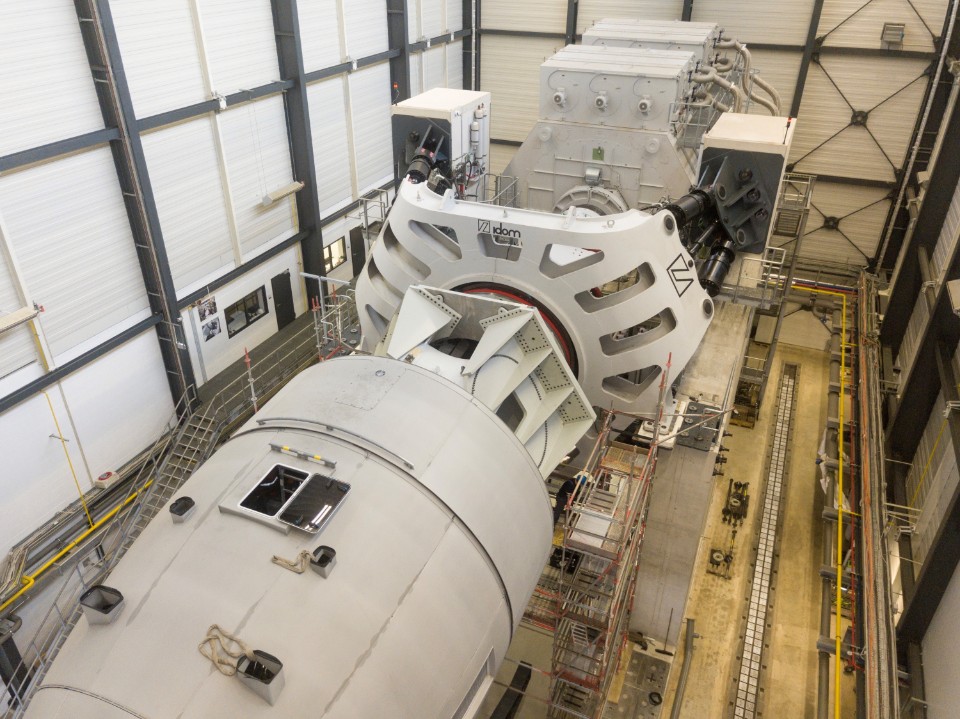Fraunhofer IWES
Turbine Certification on a Test Bench
The CertBench project is now entering phase two: Further research work and an array of experimental tests are planned in order to establish the requirements for certifying the electrical properties of wind turbines on system test benches: The nacelle of a 3 MW turbine from project partner ENERCON will undergo tests as per the guidelines relevant for certification in the Dynamic Nacelle Testing Laboratory (DyNaLab). Realistic loads and interactions between the nacelle and rotor will be simulated using real-time models and control algorithms on the test bench for hardware-in-the-loop (HiL) operation. The test methods can be validated by comparing the results of the tests with the field data. Accelerated testing under laboratory conditions has the potential to make it significantly easier for manufacturers to plan the market launch of new and modified turbine models.
Within the scope of this subproject to validate test benches, an ENERCON nacelle has been set up on the Fraunhofer IWES test bench in Bremerhaven. Following the first successful pre-tests according to TR3 and successful testing of HiL test bench operation, this project can now get started properly. The aim is to demonstrate that the grid-side loads can be realistically simulated by the virtual 36,000 V medium-voltage grid in the Fraunhofer DyNaLab. If this were the case, it would be possible to determine the electrical properties of a wind turbine on a test bench with the same degree of reliability as in the field.
Until now, measurement data from field tests have been used to certify new wind turbine types. As part of the CertBench project, the alliance partners aim to prove that typical network faults such as UVRT- and OVRT-Events can be reproduced just as realistically on a system test bench. In an emulated grid, certain faults can be generated as often as required and “at the touch of a button”. This, in turn, means the certification requirements can be tested in a time-effective and well-planned manner.
„Responding to diverse market requirements within rapidly paced development cycles are seen as joint aims for the equipment qualification on a test bench”, says Uwe Helmke, Head of System Testing and Optimisation at WRD, ENERCON’s R&D unit.
With support from the certification body FGH and the DEWI, experts of the CWD at the RWTH Aachen and Fraunhofer IWES hope to quantify the influence of the testing equipment on test objects and measurement parameters within the framework of this project funded by the German Federal Ministry for Economics Affairs and Energy (BMWi).
“Following successful preliminary testing, we are delighted that we can now use our high-performance test infrastructure in the search for answers to central questions on grid integration and, together with Enercon, develop sustainable solutions,” explained Jan Wenske, Division Director Turbine and System Technology at Fraunhofer IWES.
In parallel to these test activities, the research work will also be intensified in the phase of the project which is now getting under way. HiL test procedures traditionally demand manufacturer-specific turbine data, but the forwarding of such information can be at odds with confidentiality clauses. For this reason, Fraunhofer IWES is developing special model structures (so-called black or gray box models) and examining methods aimed at allowing manufacturers to be provided with sufficiently accurate test results based on a robust model without the disclosure of confidential data.
The setup and commissioning of a “virtual test bench” which can be used to apply HiL test methods independently of the test bench´s occupation at the time is a further focal point of this Fraunhofer IWES subproject. The simulation environment will be set up of several control units, which correspond to the main control of the test bench, the drive unit, or the control in order to emulate the dynamics of the test bench and test object. The coordinated HiL system models the entire physical system whilst also taking signal- and system-related latencies during testing on the bench into account.
Even while the project is still under way, the partners are already contributing results to the relevant committees for standards and guidelines, which means that a significant reduction in the time required for certification can be expected as early as in the medium term.
Key project data
Long title: Systematic Validation of System Test Benches by means of Type Certification of Wind Turbines
Project duration: 06.01.2017 – 11.30.2019
Project partners: CWD / RWTH Aachen, FGH Zertifizierungsgesellschaft mbH, DEWI (UL International GmbH), ENERCON GmbH
Funding volume: 4 Mio. Euro
Funding code: 0324200
